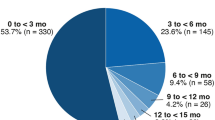Abstract
Purpose
To evaluate the short- and long-term in vivo safety and efficacy of topical bevacizumab (Avastin) application for treatment of corneal neovascularization secondary to a variety of corneal diseases.
Methods
Thirty eyes of 27 patients with progressive corneal neovascularisation (not responding to conventional anti-inflammatory treatment) due to different underlying corneal diseases received topical bevacizumab (Avastin) eye drops (5 mg/ml Bevacizumab) for 0.5–12 months (five times/day on average). At each visit, a routine Snellen visual acuity assessment was performed, followed by ophthalmic examination including fluorescein staining. Changes of corneal neovascularization and vessel diameter were assessed using morphometry of standardized digital corneal photographs.
Results
Five patients (five eyes) developed new corneal epithelial defects during topical bevacizumab treatment. In 22 patients, no new epithelial defects were observed. None of the 27 patients complained about any drug-related ocular or systemic adverse events during follow-up. No allergic reactions were observed.
Corneal photographs of 21 eyes (19 patients) could be assessed. The mean reduction in vascularized area during treatment was 61%. The mean reduction in vessel diameter under topical Avastin therapy was 24%.
Conclusions
Off-label topical bevacizumab therapy against corneal neovascularization secondary to different corneal diseases was generally well-tolerated for up to 12 months. Bevacizumab (Avastin) eye drops inhibit corneal neovascularization, and lead to a reduction of the vessel diameter. Our results suggest that off-label use of Bevacizumab eye drops is a relatively safe and well-tolerated option for the treatment of corneal neovascularization. Care should be taken in patients with epithelial defects and neurotrophic keratopathy.








Similar content being viewed by others
References
Chang JH, Gabison EE, Kato T, Azar DT (2001) Corneal neovascularization. Curr Opin Ophthalmol 12:242–249, doi:10.1097/00055735-200108000-00002
Bock F, Koenig Y, Dietrich T, Zimmermann P, Baier M, Cursiefen C (2007) Inhibition of angiogenesis in the anterior chamber of the eye. Ophthalmologe 104:336–344, doi:10.1007/s00347-007-1512-2
Cursiefen C, Chen L, Saint-Geniez M et al (2006) Nonvascular VEGF receptor 3 expression by corneal epithelium maintains avascularity and vision. Proc Natl Acad Sci U S A 103:11405–11410, doi:10.1073/pnas.0506112103
Carmeliet P, Jain RK (2000) Angiogenesis in cancer and other diseases. Nature 407:249–257, doi:10.1038/35025220
Aiello LP, Avery RL, Arrigg PG et al (1994) Vascular endothelial growth factor in ocular fluid of patients with diabetic retinopathy and other retinal disorders. N Engl J Med 331:1480–1487, doi:10.1056/NEJM199412013312203
Yoeruek E, Spitzer MS, Tatar O et al (2007) Safety profile of Bevacizumab on cultured human corneal cells. Cornea 26:977–982, doi:10.1097/ICO.0b013e3180de1d0a
Bock F, Koenig Y, Kruse F, Baier M, Cursiefen C (2008) Bevacizumab (Avastin) eye drops inhibit corneal neovascularization. Graefes Arch Clin Exp Ophthalmol 246:281–284, doi:10.1007/s00417-007-0684-4
Kim SW, Ha BJ, Kim EK, Tchah H, Kim TI (2008) The effect of topical Bevacizumab on corneal neovascularization. Ophthalmology 115:e33–e38, doi:10.1016/j.ophtha.2008.02.013
Philipp W, Speicher L, Humpel C (2000) Expression of vascular endothelial growth factor and its receptors in inflamed and vascularized human corneas. Invest Ophthalmol Vis Sci 41:2514–2522
Cursiefen C, Rummelt C, Küchle M (2000) Immunohistochemical localization of vascular endothelial growth factor, transforming growth factor alpha, and transforming growth factor beta1 in human corneas with neovascularization. Cornea 19:526–533. doi:10.1097/00003226-200007000-00025
Irigoyen JP, Moñoz-Cánoves P, Montero L et al (1999) The plasminogen activator system: biology and regulation. Cell Mol Life Sci 56:104–132, doi:10.1007/PL00000615
Blasi F (1999) Proteolysis, cell adhesion, chemotaxis, and invasiveness are regulated by the u-PA-u-PAR-PAI-1 system. Thromb Haemost 82:298–304
Bock F, Onderka J, Dietrich T et al (2007) Bevacizumab as a potent inhibitor of inflammatory corneal angiogenesis and lymphangiogenesis. Invest Ophthalmol Vis Sci 48:2545–2552, doi:10.1167/iovs.06-0570
Fernando NH, Hurwitz HI (2004) Targeted therapy of colorectal cancer: clinical experience with bevacizumab. Oncologist 9:11–18, doi:10.1634/theoncologist.9-suppl_1-11
Avery RL, Pieramici DJ, Rabena MD et al (2006) Intravitreal bevacizumab (Avastin) for neovascular age-related macular degeneration. Ophthalmology 113:363–372, doi:10.1016/j.ophtha.2005.11.019
Krum JM, Rosenstein JM (2004) New roles for VEGF in nervous tissue: beyond blood vessels. Exp Neurol 187:246–253, doi:10.1016/j.expneurol.2004.01.022
Soubrane G, Jerdan J, Karpouzas I et al (1990) Binding of basic fibroblast growth factor to normal and neovascularized rabbit cornea. Invest Ophthalmol Vis Sci 31:323–333
Bock F, Onderka J, Hos D, Horn F, Martus P, Cursiefen C (2008) Improved semiautomatic method for morphometry of angiogenesis and lymphangiogenesis in corneal flatmounts. Exp Eye Res 87:462–470, doi:10.1016/j.exer.2008.08.007
Cursiefen C, Rummelt C, Küchle M, Schlötzer-Schrehardt U (2003) Pericyte recruitment in human corneal angiogenesis. Br J Ophthalmol 87:101–106, doi:10.1136/bjo.87.1.101
Sadrai Z, Dastjerdi MH, Saban DR, Dana R (2008) Corneal penetration of topical bevacizumab (Avastin). ARVO poster, 2008.
Cursiefen C, Cao J, Chen L et al (2004) Inhibition of hemangiogenesis and lymphangiogenesis after normal-risk corneal transplantation by neutralizing VEGF promotes graft survival. Invest Ophthalmol Vis Sci 45(8):2666–2673, doi:10.1167/iovs.03-1380
Bachmann BO, Bock F, Wiegand SJ et al (2008) Promotion of graft survival by vascular endothelial growth factor a neutralization after high-risk corneal transplantation. Arch Ophthalmol 126(1):71–77, doi:10.1001/archopht.126.1.71
Author information
Authors and Affiliations
Corresponding author
Rights and permissions
About this article
Cite this article
Koenig, Y., Bock, F., Horn, F. et al. Short- and long-term safety profile and efficacy of topical bevacizumab (Avastin®) eye drops against corneal neovascularization. Graefes Arch Clin Exp Ophthalmol 247, 1375–1382 (2009). https://doi.org/10.1007/s00417-009-1099-1
Received:
Revised:
Accepted:
Published:
Issue Date:
DOI: https://doi.org/10.1007/s00417-009-1099-1




